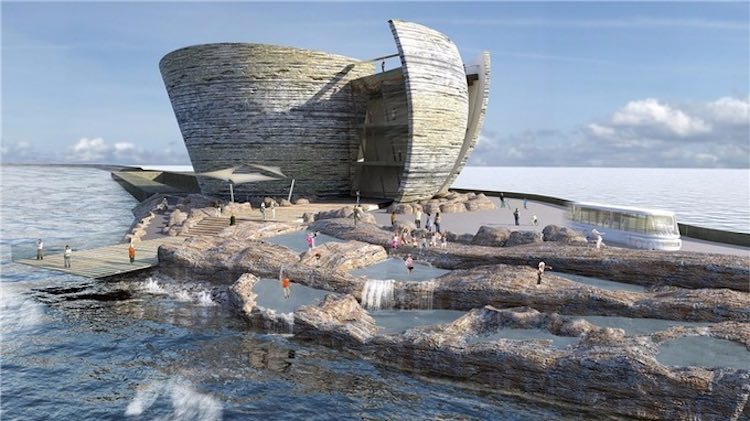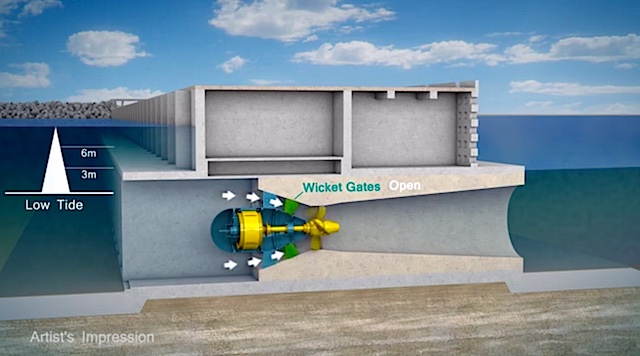This planned power plant in Wales may look like the Guggenheim Museum but its benefits far outweigh the beauty: it will use the rise and fall of ocean tides to generate enough renewable electricity to power 155,000 homes for 120 years.
When completed, the structure will produce electricity enough to displace more than a quarter million barrels of oil each year— while leaving virtually no carbon footprint.
Power plants have been generating electricity using the tides since 1966, but the Swansea project is the first to employ a radically new method of harnessing the natural forces. The secret lies in its nearly six-mile-long barrier wall that will enclose a huge amount of water in an artificial “tidal lagoon”.
The lagoon captures and holds seawater at high tide. As the tide goes out, water in the 4.5 square mile lagoon will be as much as 27 feet higher than the water outside its walls. This tremendous pressure will be routed through 26 turbines, rushing out to sea until the water level equalizes on both sides of the lagoon. At high tide, the flow is reversed, keeping the sea out of the lagoon until it reaches maximum height, then letting the water rush through the turbines again until it fills up the lagoon.
The amount of water rushing through the turbines each day would fill 100,000 Olympic swimming pools.
Speaking of which, the Swansea Bay Tidal Lagoon will not only crank out clean energy, but could be used as a sports arena, aquaculture farm, and seaside sculpture garden.
The lagoon can also be used as a giant arena for sailing and cycling sports. Designers have plans for sculptures that appear to disappear into the water or rise out of it as the tides roll in and out.
The Swansea Bay Tidal Lagoon will also feature a community aquaculture farm growing oysters, kelp and other local sea crops.
The location in Swansea, Wales was chosen because it has some of the highest tide differences in the U.K., maximizing the amount of water that can be used to turn turbines and generate the 420 gigawatt hours per year.
The UK Energy Ministry approved planning in June and construction is expected to start as early as sometime in 2017. Its $1.5 billion price tag relies on government subsidies for 35 years, but the builders have suggested they could give up much of the subsidies in exchange for approval on two more tidal lagoon plants at Cardiff and Newport.
(WATCH the video below from Preconstruct)






















The guy building the power station has bought a disused quarry in Cornwall and plans to reopen it as a super quarry to mine the rock for the walls of the tidal barrage. The quarry is in an area of outstanding natural beauty (AONB) and site of social scientific interest (SSSI). To move the rock he is planning to build a million tonne breakwater slap bang on the middle of the Manacles, a marine conservation zone (MCZ). He has tried to do all this without proper planning consent or environmental impact assessments and the local community are about to take the issue to Judicial Review as a result. If he succeeds, he plans to sell himself the rock for the barrage, make the energy, claim super high subsidies from the government for it then sell it on to an energy company belonging to…. Wait for it… His wife. Draw your own conclusions and find out more at http://www.cads2015.com